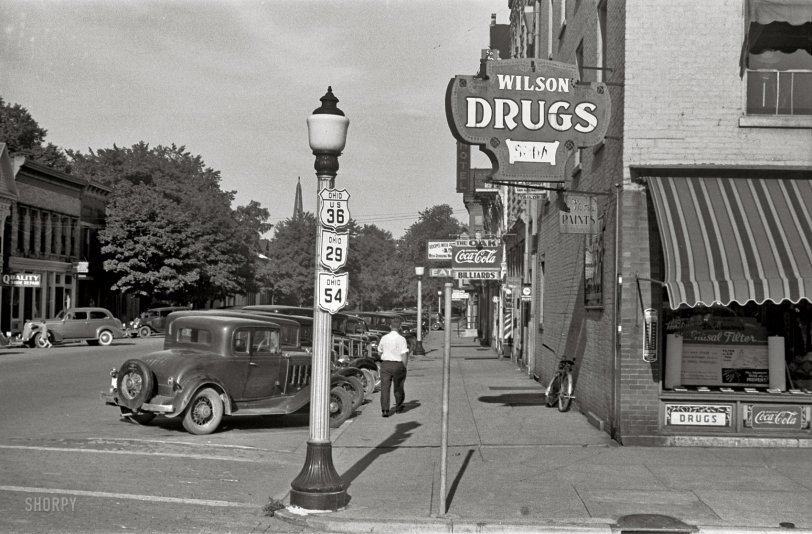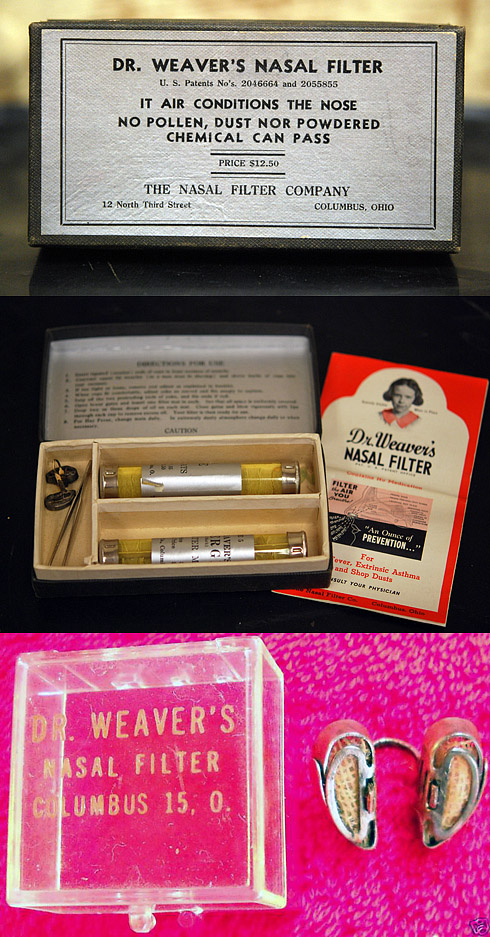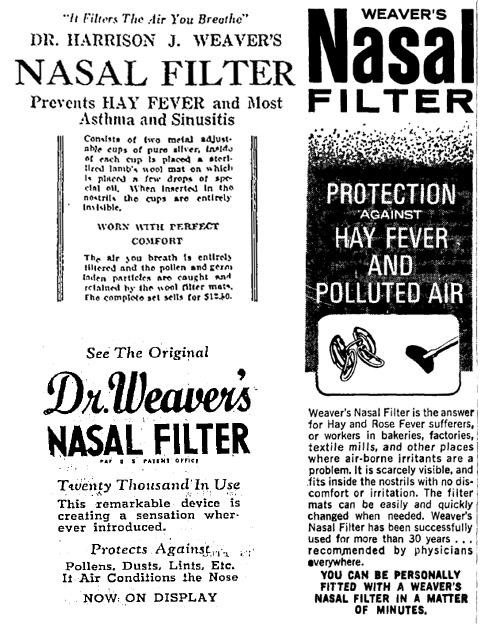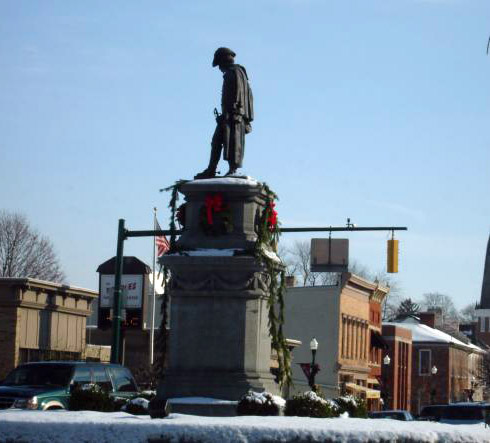


Framed or unframed, desk size to sofa size, printed by us in Arizona and Alabama since 2007. Explore now.
Shorpy is funded by you. Patreon contributors get an ad-free experience.
Learn more.

- Details, Details
- What's that building to the left of the tower?
- Coal Barges
- Bromo-Seltzer
- Inner harbor
- The Basin
- What a headache!
- Giant stepladder?
- Baldwin 62303
- Baldwin VO-1000
- Cold
- No expense spared
- Tough Guys
- Lost in Toyland
- And without gloves
- If I were a blindfolded time traveler
- Smoke Consumer Also Cooks
- Oh that stove!
- Possibly still there?
- What?!?
- $100 Reward
- Freeze Frame
- Texas Flyer wanted
- Just a Year Too Soon
- WWII -- Replacing men with women at the railroad crossing.
- Yes, Icing
- You kids drive me nuts!
- NOT An Easy Job
- I wonder
- Just add window boxes
Print Emporium
Street Life: 1938

August 1938. Urbana, Ohio. "Street scene." 35mm nitrate negative by Ben Shahn for the Farm Security Administration. View full size.
Drugstore Aroma
I wish I could walk into that corner drugstore and smell that wonderful, mysterious aroma that was an intrinsic part of the drugstore of my childhood. I don't know, but I've always thought it must have been the commingling of the smells of medicines, the soda fountain, tobacco, and the newspapers and magazines. It's been decades since I last experienced that wonderful aroma, but I'll always remember it. I think anybody of "a certain age" will know what I'm talking about.
Give me the family-owned store any day!
When we traveled by car visiting small towns, I loved to check out the family-owned drug stores. Some were like general stores. I also liked to check out each town's library and family-owned hardware stores. Feed and grain stores were also fascinating. They are throwbacks to this era. Its hard to find a non-chain anything any more. In the old days, we could chat with the owner. Today everything is owned by out-of-state corporate offices. Give me the family owned store any day!
A Lazy Summer Day
Ah, to step out onto this sidewalk on a lazy summer morn. Fresh from a $1.50 room, then grab a bite of breakfast next door, and stroll into Oak Billiards to greet the morning boys, and while away the day with friendly games of 8-ball.
Pole mystery
Possibly used to hold a stop sign, replaced by a traffic signal that may be suspended by cable over the center of the intersection.
Interesting to compare the faux-olde streetlights in the Google street view to the real things. Presumably the former supplanted the ubiquitous mercury-vapor standards that proliferated starting in the mid-fifties.
Depressing
What I find depressing about the comparison between then an now is how so many of those great trees have gone (Dutch Elm Disease) and simply not been replaced by anything except concrete.
Re: Angle-parking
Angle-parking (especially down the centre of the road, either in two rows facing each other or a single) was always easier with horse and cart than parallel or right-angle parking. Towns where you still see angle parking are usually ones where the streets have never been narrowed to accommodate several lanes of traffic and/or where horse and cart transportation hung on longer.
Smaller rural towns and cities in the mid-west are more likely to still have angle-parking than the bigger cities.
I can name only a few towns that I have been in in the last few years where angle parking still exists.
====
COMPLETELY forgot Smiths Falls, south of Ottawa. How could I forget when I am there at least once a month? Angle parking down both sides of the main drag, but mix of parallel and right-angle everywhere else...
Everyone celebrate!
It's a Festivus pole.
What's the pole?
I wonder what the pole is for — the one to the right of the lamp post, sticking up next to the curb. It doesn't seem to have a bracket on it that would suggest something else is supposed to attach to it. Ideas, folks?
Another angle on angle parking
Angle parking in our small community main street was eliminated many years ago by the state much to the chagrin of locals. Despite the outcry, MDOT claimed that "because your main street also serves as state highway M69, the change from angle to parallel parking is because of safety factor."
Ah, Urbana
I grew up in Urbana in the sixties. If I am correct, that is the north side of the square looking north. AND, if my memory serves me, everything was in black and white back then.
[We're looking east along Scioto Street. See the Street View below. - Dave]
Dr. Weaver's Nasal Filter
Now that's something you don't see much of anymore. I'd like to see how that works.
[It "air-conditions the nose" and guards against the scourge of "loose nose muscles." The Nasal Filter (1930s retail price $12.50) was the brainchild (nosechild?) of Ohio Wesleyan alum Harrison "Doc" Weaver, trainer and traveling team physician for the St. Louis Cardinals. There are hundreds of ads for this nasal nostrum (which held a pair of oil-soaked lambswool pads inside the nose) in the archives from 1936 to 1972. Below, ads from 1937, 1940 and 1967. Dr. W seemed to feel that his "gadget" would benefit distance runners if used without the filter pads: "After a runner travels about a mile, and starts losing strength, the muscles in his nose loosen and he is unable to breathe fully. The gadget would hold the nostrils slightly distended, allowing free breathing, and holding up the athlete's vitality." - Dave]


See U.S. Highway 36!
Interstate highways have replaced large sections of the best known US highways, such as U.S. 30 (Lincoln Highway), U.S. 40 (National Road -- Main Street USA), U.S. 80 (The Old Spanish Trail) and of course the immortal U.S. 66 (Steinbeck's Mother Road). The "in between" routes offer glimpses of a smaller-town America.
U.S. 36 (like all even-numbered highways, an east-west route) reaches about 120 miles east of Urbana but seems to end in Uhrichsville, due south of Akron. Heading due west, the road passes through many small towns whose names reflect the pride or hopes of 19th century settlers.
Cities of note include Indianapolis, Decatur, Springfield, St. Joseph and Denver, but the road misses larger cities served by U.S. 30 and 40. After passing through Boulder, U.S. 36 loops up into Rocky Mountain National Park, joining U.S. 34 to form the highest altitude through road in the nation (elevation 12,090 feet).
U.S. 34 has its own charms, running back east about 80 miles above 36, but eventually slanting up to terminate in Chicago. I invite Shorpy readers to find either road on Google Maps, then zoom in till the small towns are visible and just start reading off the names as you "travel" the road.
What a hot summer day!
Trees in full leaf, a guy with rolled-up shirtsleeves and no hat, strongly delineated shadows -- that sidewalk must be glowing warmth.
Thanks for the trip to the summer past of our parents and grandparents.
Anytown, USA
This could be almost any small town in the US in 1938. Notice that a kid has left his bike leaning against a wall, and he undoubtedly isn't afraid that anyone will take it.
It is indeed Urbana
Spent my early years there. The two buildings to the left right of the monument in this picture are the same two buildings on the opposite side of the street in the Shorpy picture above.

Things Go Better
Again, Coca-Cola, the only real advertiser in this photo.. They are right there at The Oak, a pool hall, and we see them again at Wilson Drugs. Americana is almost defined by Coke, its presence is part of our 20th century history.
The view to-day
Looking east along Scioto Street. Same two-story building on the left.
Angle parking
You used to see more of this type of parking available in the downtown areas of small towns. It allowed easier in and out and you could get more cars parked on the street, but I guess it took up more road space.
Americain
Great photo! Makes you automatically look for Andy Hardy. Great way to begin year #4!
Love the vintage highway shields!
But is this really Washington Court House? US 36 doesn't go anywhere near it. Could this be Urbana? Ohio 29 and US 36 both go through it, and Ohio 54 begins in that town.
[I think you're right. The adjacent frames are labeled Urbana. - Dave]
























On Shorpy:
Today’s Top 5